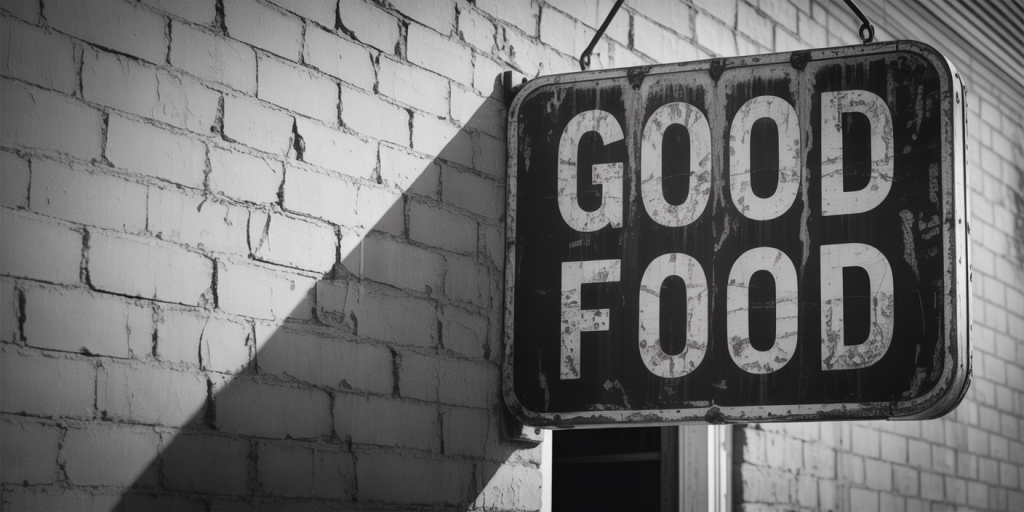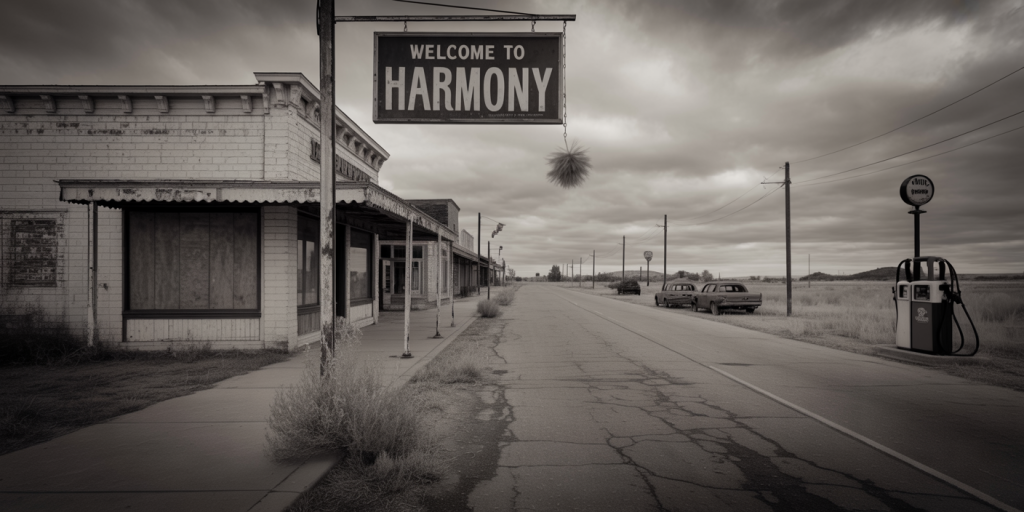Under the Gaze of Walker Evans, Concrete Learns to Weep
Rain does not fall on bricks in Walker Evans’s world—it seeps into them. His camera did not merely capture structures; it unveiled the sorrows hidden between concrete slabs, beneath rusted awnings, behind chipped paint. There is a quiet grief in his America. Not explosive. Not desperate. But quiet. Dignified. Earnest.
Evans wandered through the visible world, yet what he brought back were the invisible wounds of a society in motion and in stillness. His lens was an elegy to what endures when people forget to look. With Evans, even a porch without a soul becomes a soul. A wall speaks. A window breathes. And the concrete? The concrete weeps—not from erosion, but from memory.

Table of Contents – A Poetic Index of Silence
- Boarded Windows, Open Hearts
- When Sidewalks Speak of Absence
- Rust as a Language of Time
- Porches That Wait Forever
- Doors Left Half Closed on Purpose
- Paint Peeling Like Forgotten Promises
- The Stillness in Empty Chairs
- Letters Lost on Mailboxes
- Shadows Under Rusted Signs
- Brick by Brick, the Breath of Grief
- Asphalt Dreams and Dusty Hope
- Bicycles without Riders
- Curtains Drawn to Keep Out Memory
- A Fence that Separates Past from Past
- Clotheslines Hung with Longing
- Grocery Stores Where Time Spoiled
- Faces Etched into Reflected Glass
- Roofs That Remember Rain
- A Town as a Diary Left Open
- Tears the Pavement Knows by Name
Boarded Windows, Open Hearts
A window boarded up is not an end in Evans’s America—it is a beginning. Behind each nailed plank, something once thrived. Now, it listens. The planks are not barriers. They are shields.
Evans frames these closures not with finality but with reverence. The absence of light within becomes a metaphor for memory. Sealed off, yes—but never silenced.
When Sidewalks Speak of Absence
In Evans’s gaze, the sidewalk becomes more than stone. It carries ghostly footfalls, conversations never finished, and hopes that turned corners too quickly.
His sidewalk stretches not in space but in time. We walk along with him, tracing loneliness that is neither bitter nor abandoned—only honest.
Rust as a Language of Time
Rust in his photos is not decay—it’s dialogue. It speaks of years, of weather, of hands that once oiled hinges and no longer do.
Evans gives rust a texture so tactile we can nearly feel its flake on our skin. He reminds us: nothing truly disappears. It transforms.
Porches That Wait Forever
There are porches in his work that seem to exhale. Rocking chairs unmoved, stairways unstepped. These are not architectural features. They are characters.
Evans treats them with the dignity of still performers. Waiting, not forgotten. Their silence is not hollow—it is full of time.
Doors Left Half Closed on Purpose
A half-closed door, in Evans’s framing, is not indecision. It is a sigh. It is a way to keep the world partially out while still hoping it might knock again.
He captures these thresholds with aching ambiguity. They are both invitation and farewell.
Paint Peeling Like Forgotten Promises
Peeling paint becomes poetry in his eye. It tells stories of repaintings never done, of care once present but now economically impossible.
The texture is rich with neglect—but it’s never judgmental. Evans’s lens doesn’t scold. It mourns gently, with grace.
The Stillness in Empty Chairs
An empty chair is a person unspoken. Whether on porches, behind glass, or beneath awnings, these chairs are not props. They are presences.
Evans lets them sit with us. Not as absence, but as echo. We feel their warmth even as they cool in the shade of abandonment.
Letters Lost on Mailboxes
Even the mailboxes in his images feel wounded. Their slots are dry. Their names scratched or gone.
These boxes are not hopeful containers anymore—they are monuments to messages no longer sent. Communication, interrupted by time.
Shadows Under Rusted Signs
Evans often captures shadows beneath signs that promise things they no longer provide—groceries, laundry, hope.
These shadows are not mistakes. They are stains of light. Their presence haunts the facade, whispering of commerce and connection that used to bloom.

Brick by Brick, the Breath of Grief
Each brick in Evans’s towns breathes. They are not just part of walls—they are witnesses. Laid by hands now gone, they hold temperature, weather, sorrow.
His camera traces them with intimacy. Grief is not grand. It is brick by brick. And every line of mortar is a line of verse.
Asphalt Dreams and Dusty Hope
Roads in Evans’s vision are dreams barely remembered. Cracks and gravel do not mar them—they enrich them. His paths do not invite departure. They ask, instead, for reckoning.
Dust settles, but it never hides. Evans lets us see it—all the memories, hopes, and footsteps beneath the grit.
Bicycles without Riders
A bicycle leaning against a wall with no child in sight. That, too, is Evans. The waiting. The past motion.
It becomes metaphor: for growth paused, for movement remembered, for innocence now rusting. The bicycle is still, but the story moves.
Curtains Drawn to Keep Out Memory
Curtains are barriers not of cloth, but of emotional weather. Drawn tightly, they try to preserve something inside. Or to forget what lies beyond.
Evans catches them in windless moments, when they hang like arrested breaths. Their folds speak the language of solitude.
A Fence that Separates Past from Past
In Evans’s America, a fence does not divide neighbor from neighbor—it divides one memory from another. It demarcates not property, but pain.
Often leaning, often broken, these fences confess their own weariness. They are not guardians. They are just tired.
Clotheslines Hung with Longing
Evans often caught the delicate ballet of laundry—shirts, sheets, dresses—hanging against sky. The breeze becomes a kind of soft breath.
These clotheslines connect people to sky, to weather, to time. Even absence flutters. Even longing dries in sunlight.
Grocery Stores Where Time Spoiled
Evans’s storefronts are not empty. They are museums of the everyday. A can of peaches with faded label. A shelf of dusted-off jars. Time, curated and left to wither.
We do not shop in these places—we contemplate. His lens asks: what do we truly hunger for?
Faces Etched into Reflected Glass
Sometimes we see faces in windows—not because they’re there, but because the glass becomes memory.
Evans allows reflections to contain ghosts. Smiles once given. Eyes that looked through this same pane at a changing world. The glass becomes an altar.
Roofs That Remember Rain
The shingles in his photos do not gleam. They sag, they darken, they recall storms. They are not protection. They are burdened guardians.
Evans composes them like musical bars—each tile a note in the lullaby of survival. The roof doesn’t shout. It whispers.
A Town as a Diary Left Open
His towns are not towns—they are confessions. Their buildings are entries, their sidewalks margins, their gutters parentheses.
To walk with Evans is to read a diary not your own, but strangely familiar. Each photograph a page left open by time.

Tears the Pavement Knows by Name
And finally, the concrete. Not just structure, but memory. Not blank slate, but palimpsest. The cracks are not flaws—they are veins.
Evans teaches us that even the unyielding can cry. Concrete does not weep like we do. It weeps in silence, in echo, in dust.
FAQ – Questions and Answers
Who was Walker Evans?
Walker Evans was an American photographer best known for documenting everyday life in the United States during the Great Depression. His work is iconic for its understated, honest portrayal of American architecture, people, and streets.
What made his style unique?
Evans used straight-on compositions, natural light, and unmanipulated settings. He avoided dramatization, focusing instead on quiet realism. His style was poetic in its restraint.
Why is his work considered poetic despite being documentary?
Because Evans saw feeling in structure. He let objects, buildings, and settings speak without imposing narrative. In their stillness, a kind of deep emotional resonance emerged.
What was his emotional lens?
Empathy. Evans did not pity or sensationalize. He dignified. He understood that grief resides not only in tragedy, but in the forgotten corner store, the closed curtain, the empty chair.
How does rain or texture play into his imagery?
Texture in Evans’s photos replaces color. Rain, rust, peeling paint—all are metaphors for time’s passage. They give the image not just aesthetic depth, but emotional weather.
Final Reflections – The Crying Brick
Walker Evans photographed the stillest places and found the deepest sounds. His lens was not dramatic, but it was devout. He knelt before the ordinary and listened. And what he heard were echoes—of laughter, of hunger, of waiting, of leaving.
Under his eye, a brick wall is not just a surface. It is a witness. The sidewalk is not just ground—it is a record. And the concrete? The concrete weeps. Not loudly. But truthfully.
To view Evans is to remember how to look. Slowly. Without spectacle. With reverence. Because even what doesn’t move can move us.
